Gur Emir complex - mu
mausoleum
The Gur-e-Amir Mausoleum is the the final resting place of Amir Timur, a.k.a Tamerlane, the brilliant but ruthless conqueror who dominated central Asia in the final decades of the 14th century up to his death in 1405.
The site of the tomb was originally a khanqah and madrasa endowed by Timur's grandson, Muhammad Sultan. In 1403 it became a mausoleum. Eventually it became the restin place for the remains of Timur himself, his spiritual counselor, his grandson Ulug Beg and his son Shah Rukh Mirza, the second ruler of the Timurid empire, making the Gur Emir the mausoleum Timurid dynasty.

inkompoort
The pishtaq of the complex is covered by blue glazed tiles and above the entrance theres a nice muqarna of the stalachtite type.
Looking from below you can see a half 24-pointed star, around it a circle of five 5-pointed stars and two 6-pointed stars in the lower corners. Not the vertices of the stars but those of the polygons in which the stars are inscribed are connected building the muqarna from the bottom to the apex.
Much of the original tile work survives on the portal. It is executed in a technique known as mosaic faience, which can be best understood as a jigsaw. In mosaic faience, each piece of differently glazed ceramic is arranged to form a jigsaw-like assemblage, with each piece set into a plaster bed and placed on the wall and attached. Mosaic faience is made by a tile cutter who sat before a palette of glazed tiles and cut out the desired shape from those tiles. The cut pieces were then assembled into the pattern resembling a jigsaw puzzle.
Mosaic faience developed in the cities of Shiraz, Kirman and Yazd, under a dynasty called the Muzaffarids that succeeded the Ilkhanids. The mosaic faience found on the facade of the Gur-i Amir is evidence of the relocation of artists from Timur’s conquered territories to his capital. The inscription at the top confirms
this, stating: “the work of the weak servant Muhammad ibn Mahmud al-Isfahani.”
This signature is of an artist from Isfahan who has been transplanted to Samarqand where he contributed a regional style into the emerging multi-regional repertoire of Timurid architecture.

